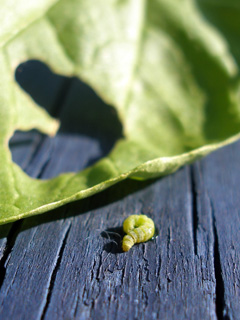 story by Char Vandermeer Beetles, worms, ants and aphids, oh my! I’m convinced that because my Pennsport deck is home to the only vegetables within, oh, most of the neighborhood, every pest in the ’hood sees my garden as an oasis of tastiness. Last year’s battles included all the garden-variety bugs you’d expect, plus whiteflies, cabbage loopers and brown marmorated stink bugs.
story by Char Vandermeer Beetles, worms, ants and aphids, oh my! I’m convinced that because my Pennsport deck is home to the only vegetables within, oh, most of the neighborhood, every pest in the ’hood sees my garden as an oasis of tastiness. Last year’s battles included all the garden-variety bugs you’d expect, plus whiteflies, cabbage loopers and brown marmorated stink bugs.
It was an exciting year.
While the chemical-killer nuclear option is tempting, there are plenty of non-toxic natural remedies. For instance, “good” bugs, like adorable ladybugs. One adult ladybug can eat up to 1,000(!) aphids per day, and they’ll even eat the eggs of cucumber beetles. Talk about an oasis of tastiness. Greensgrow Farms sells tiny buckets of squirming ladies, ready for release. (They go for $12 for 1,500, which will cover 700 square feet.)
Because aphids and cucumber beetles transmit diseases like the dreaded mosaic virus and bacterial wilts, it’s best to hedge your bets and employ several strategies. Strangely, aluminum foil is a great partner for your tiny red friends. Rather than pitching that barely used and mostly clean foil, rip it into strips and place it at the base of your plants. This aluminum mulch should cover at least 50 percent of your container’s soil, and can repel up to 95 pecent of your aphids while simultaneously discouraging cucumber beetles.
Moving right along… Whiteflies, which are nearly invisible to the human eye, seem particularly fond of tomatoes, so plant a few marigolds and make some yellow glue traps. Marigolds repel both whiteflies and aphids, but they can be toxic to some veggies, like beans, so plant them in their own containers. Making glue traps is a super-satisfying and super-easy solution, too. Simply buy a sheet of yellow poster board, boil up a quart of water and a quart of corn syrup, allow the solution to cool a bit and then slather it on. The yellow attracts the insects, and the sticky mess traps them.
Glue’s good, but squishing the monsters works pretty well, too. Both tomato hornworms and cabbage loopers are easy to identify by the carnage they leave in their wake: they can demolish a perfect healthy plant in a matter of days. The former will chomp leaves down to the stalk, and the latter will make Swiss cheese of your plant’s leaves. They’ll both leave piles of green worm poop in their wake. Hornworms are rather terrifying-looking creatures—they can grow up to four inches long and are as thick as an adult’s thumb; then there’s the whole horn thing. While gutsier gardeners than myself (hi, Mom!) have no problem plucking them off and smushing them with their bare hands, garden gloves provide a welcome layer of insulation. Loopers, only about an inch long, propagate quickly, and where there’s one, there’s likely a dozen. Nothing satisfies like squishing green worm goop out of these nasties, except maybe throwing them onto the neighboring roof and watching sparrows devour them alive.
If potions are your thing, Neem oil is a great multi-purpose organic garden aid. It’s readily available at any garden center. You can also, of course, brew your own killing concoction (see below).
Dear gardeners, I’ve saved the worst news for last: brown marmorated stink bugs. These invasive bugs bore straight through your veggies, leaving brown mush in their wake. Alas, they left their waspy predators back in Asia, from whence they came. There ain’t much you can do except identify them, preferably when they’re still eggs or freshly hatched, and smash them into gooey pulp. They typically deposit their pale green eggs on the undersides of leaves in clutches of approximately 28. Newborns look like diamond-shaped beetles, about the size of an adult ladybug, with black heads and yellow bodies with black marking. Kill them dead. Use extreme prejudice.
Char Vandermeer tends a container garden on her South Philly roof deck; she chronicles the triumphs and travails at plantsondeck.com
Bug Zapper
1 cup stems, seeds, leaves
and flowers of thyme,
lavender and yarrow
2 Tbsp. coffee grounds
Water
1/4 cup milk
1 tbsp. of natural dishwashing soap
- Combine herbs and coffee grounds in
a pot of water and steep for 24 hours. - Strain the solution, reserving the liquid and
composting or discarding the herbs. - Add milk and dishwashing soap to the strained solution.
- Pour into a spray bottle, shake, then spray the afflicted plants, making sure to hit the undersides of the leaves.

